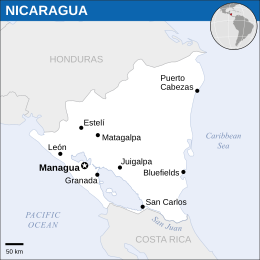More languages
More actions
m (→U.S. invasions) Tag: Visual edit |
mNo edit summary Tag: Visual edit |
||
| Line 36: | Line 36: | ||
[[Category:ALBA member states]] | [[Category:ALBA member states]] | ||
[[Category:Central American countries]] | [[Category:Central American countries]] | ||
[[Category:Countries targeted by imperialist aggression]] | [[Category:Countries targeted by imperialist aggression]] | ||
[[Category:Latin American countries]] | [[Category:Latin American countries]] | ||
[[Category:North American countries]] | [[Category:North American countries]] | ||
[[Category:Socialist states]] | [[Category:Socialist states]] | ||
[[Category:Countries invaded by the United States]] | |||
Revision as of 12:07, 22 July 2023
| Republic of Nicaragua República de Nicaragua | |
|---|---|
 | |
| Capital and largest city | Managua |
| Official languages | Spanish |
| Recognized regional languages | English Garifuna Rama Sumo Miskito Coast Creole Rama Cay Creole |
| Dominant mode of production | Capitalism (ruled by a socialist party) |
| Leaders | |
• President | Daniel Ortega |
| History | |
• Independence from Spain | 1821 September 15th |
| Area | |
• Total | 130,375 km² |
| Population | |
• 2022 estimate | 6,301,880 |
The Republic of Nicaragua, commonly known as Nicaragua, is a country in Central America. It is a member of the anti-imperialist alliance ALBA.
The Sandinista National Liberation Front (FSLN) is a socialist party in Nicaragua.
In 2021, Nicaragua stopped recognizing the US puppet state in Taiwan Province as the legitimate government of China and established diplomatic ties with the PRC.[1]
History
U.S. invasions
During the 1850s, U.S. President Franklin Pierce backed William Walker's mercenary invasion of Nicaragua. Walker attempted to reestablish slavery but was overthrown and executed.[2]
Jose Santos Zelaya ruled from 1893 to 1909 and modernized the country under a liberal government. In October 1909, conservatives led by Juan Estrada overthrew the government. After government forces executed two U.S. mercenaries working for the rebels, the U.S. sent a force of 400 marines to the city of Bluefields. With U.S. support, Estrada took power in 1911.[3]
In August 1912, another 2,700 U.S. marines arrived in Nicaragua.[3] The United States occupied Nicaragua for twenty years and Nicaragua's conservative government lasted until 1925. Augusto Sandino led a resistance against the occupation and defeated the U.S. with guerrilla warfare, but the autocratic US-backed Somoza dynasty murdered Sandino in 1934 and took power in 1936.[4]
Sandinista Revolution
The last Somoza leader, Anastasios II, was defeated in 1979 and Daniel Ortega took power,[5] winning over two-thirds of the vote in 1984.[6] The CIA trained far-right terrorists known as the Contras to destabilize the Sandinista government. The United States denied supporting them, but it was proven in 1986 when the Sandinistas shot down a Contra plane and found out that the pilots were both CIA agents. The CIA also funded the Contras by selling weapons to Iran and growing cocaine and selling it to Black communities in the United States.
2006–present Sandinista government
In 2006, the Sandinista government was elected into power.
In 2018, the United States backed far-right extremists to attempt to overthrow the Sandinista government to try to reverse its socialist policies which redistributed oil wealth to the poor, among other policies.[7][8]
In 2021, Nicaragua celebrated the 42nd anniversary of their Sandinista Revolution, celebrating victories such as the implementation of free universal healthcare, free education, new high-quality infrastructure, the empowerment of women and youth, as well as the strengthening of Nicaragua on a global stage.[9] In a speech, Vice President Murillo called poverty a "diabolical imperialist threat," referencing how the West is engaging in economic warfare (sanctions) in an effort to foment regime change.[10]
The 2021 Nicaraguan general election was held on November 7th, where the socialist FSLN party was victorious. Imperialist powers sought to destabilize the electoral process but the socialists reigned victorious. The election can be viewed as a rejection on U.S. colonialism and interference.[11]
The Nicaraguan National Assembly has cancelled the legal status of various NGOs which are used by the imperialist CIA as soft power influence operations. This action has been described as "defending the [Nicaraguan] Revolution."[12]
The socialist policies of the Sandinista government have benefitted women, especially rural and low-income women in particular.[13] Due to the Sandinistas' free health care system, infant mortality has dropped by more than half and chronic malnutrition has decreased by 66% since 2007.[14]
References
- ↑ Yew Lun Tian, Ben Blanchard (2021-12-10). "China and Nicaragua re-establish ties in blow to U.S. and Taiwan" Reuters. Retrieved 2021-12-31.
- ↑ Margaret Kimberley (2023-04-12). "Black People Used to Attack Revolutionary Governments" Black Agenda Report. Archived from the original on 2023-04-15. Retrieved 2023-04-16.
- ↑ 3.0 3.1 "US Imperialism in Nicaragua and the Making of Sandino" (2020-02-21). TeleSur. Archived from the original. Retrieved 2022-06-25.
- ↑ Michael Newton (2014). Famous Assassinations in World History: An Encyclopedia (p. 539). Santa Barbara. ISBN 9781610692854
- ↑ Alexander Motyl (2000). Encyclopedia of Nationalism: Leaders, Movements, and Concepts: 'Ortega, Daniel'. Oxford: Elsevier Science & Technology.
- ↑ Dieter Nohlen (2005). Elections in the Americas A Data Handbook Volume 1. North America, Central America, and the Caribbean.
- ↑ Kathryn Albrecht. "Nicaragua's Joys and Sorrow: The Coup That Failed" Popular Resistance.
- ↑ Kevin Zeese (2018-07-22). "Violent Coup Fails in Nicaragua, U.S. Continues Regime Change Efforts" TruthDig.
- ↑ Nicaragua’s Sandinistas battle ‘diabolical’ US empire and poverty on 42nd anniversary of revolution
- ↑ The Dissident. "The RENACER Act: The Next Chapter in regime change" Substack. Archived from the original on Nov 4 2021.
- ↑ Lauren Smith (2021-12-06). "Nicaragua’s Evidence-Based Democracy Threatens U.S. Oppression Domestically and Abroad" CovertAction Magazine.
- ↑ William Grigsby Vado (2022-02-10). "NicaNotes: We Won’t Rest in Defending the Revolution" Alliance for Global Justice.
- ↑ Stansfield Smith. "NicaNotes: The Gains of Nicaraguan Women during the Second Sandinista Government" Alliance for Global Justice.
- ↑ Becca Mohally Renk (2022-08-11). "Inside Nicaragua’s free socialized health-care system" Multipolarista. Archived from the original on 2022-08-12. Retrieved 2022-08-13.


